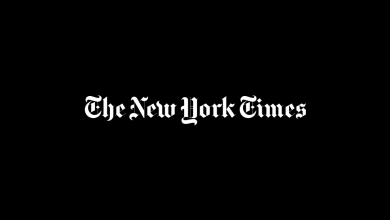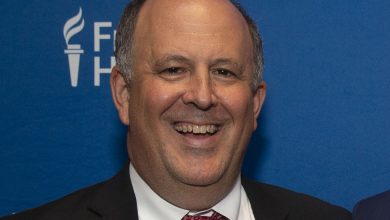Wages and Prices Slow Unevenly, Reflecting ‘Rocky and Bumpy’ Economy

Inflation isn’t as high as it was last year. The job market isn’t as hot. The economy is slowing down. But none of this is happening as quickly or as smoothly as Federal Reserve officials would like.
The latest evidence came on Friday, when a set of government reports painted a picture of an economy that is generally headed in the direction that policymakers want, but is taking its time to get there.
“We knew that inflation was going to be rocky and bumpy,” said Megan Greene, chief economist for the Kroll Institute. “We found peak inflation, but it’s not going to be a smooth path down.”
Consumer prices were up 4.2 percent in March from a year earlier, according to the Fed’s preferred measure of inflation, the Personal Consumption Expenditures index, the Commerce Department said Friday. That was the slowest pace of inflation in nearly two years, down from a peak of 7 percent last summer.
But after stripping out food and fuel prices, a closely watched “core” index held nearly steady last month. That measure rose by 4.6 percent over the year, compared with 4.7 percent in the previous reading — a figure that was revised up slightly.
Wages, meanwhile, continue to rise rapidly — good news for workers trying to keep up with the rising cost of living, but a likely source of concern for the Fed.
Data from the Labor Department on Friday showed that wages and salaries for private-sector workers were up 5.1 percent in March from a year earlier. That was the same growth rate as in December, and defied forecasters’ expectations of a modest slowdown. A broader measure of compensation growth, which includes the value of benefits as well as pay, actually accelerated slightly in the first quarter.
The Fed has been raising interest rates for more than a year in an effort to cool off the economy and bring inflation down to the central bank’s target of 2 percent per year. The data on Friday is likely to add to policymakers’ conviction that their work is not done — officials are widely expected to raise rates a quarter percentage point, to just above 5 percent, when they meet next week. That would be the central bank’s 10th consecutive rate increase.
Wage data is a particular focus for Fed officials, who believe that the labor market, in which there are far more available jobs than workers to fill them, is pushing up pay at an unsustainable rate, contributing to inflation. Other measures had suggested a more significant slowdown in wage growth than showed up in the data on Friday, which is less timely but generally considered more reliable
“If any Fed officials were wavering on a May rate hike,” Omair Sharif, founder of Inflation Insights, wrote in a note to clients on Friday, the wage data “will likely push them to support at least one more hike.”
But a crucial question is what comes after that. Central bankers forecast in March that they might stop raising interest rates after their next move. Jerome H. Powell, the Fed chair, could explain after the central bank’s rate announcement next week if that is still the case. The decision will hinge on incoming economic and financial data.
Investors largely shrugged off the data on Friday morning, focusing instead on a week of robust profit reports that suggest corporate America has yet to fully feel the pinch of higher interest rates. The S&P 500 index rose 0.5 percent in midday trading. The yields on Treasury bonds, which track the government’s cost to borrow more money and are sensitive to changes in interest-rate expectations, fell slightly.
The Fed faces a delicate task as it seeks to raise borrowing costs just enough to discourage hiring and ease pressure on pay, but not so much that companies begin laying off workers en masse.
Higher interest rates have already taken a toll on housing, manufacturing and business investment. And data from the Commerce Department on Friday suggested that consumers — the engine of the economic recovery to date — are beginning to buckle. After rising strongly in January, consumer spending barely grew in February and was flat in March. Americans saved their income in March at the highest rate since December 2021, a sign that consumers may be becoming more cautious.
“You’re seeing some of that robustness to start the year really start to reverse a little bit,” said Stephen Juneau, an economist at Bank of America.
Many forecasters believe the recovery will continue to slow in the months ahead — or may already have done so. The data from March does not capture the full impact of the collapse of Silicon Valley Bank and the financial turmoil that followed.
“If you take a picture of the data as it was in the first quarter, you’re left with this impression of still robust economic activity and inflation that’s still too high and too persistent,” said Gregory Daco, chief economist at EY, the consulting firm previously known as Ernst & Young. If there was real-time data on spending, credit standards and business investment, he said, “that would tell a very different picture from what the first-quarter data would indicate.”
The challenge or Fed officials is that they cannot wait for more complete data to make their decisions. Some evidence points to a more substantial slowdown, but other signs suggest that consumers continue to spend, and companies continue to raise prices.
“If we see inflation that warrants us needing to take additional pricing, we’ll take it,” Brian Niccol, chief executive at the burrito chain Chipotle, said during an earnings call this week. “I think we’ve now demonstrated we do have pricing power.” The company raised its menu prices by 10 percent in the first quarter versus the same period last year.
Wage growth is a particularly thorny issue for the Fed. Faster pay gains have helped workers, particularly those at the bottom of the earnings ladder, keep up with rapidly rising prices. And most economists, inside and outside the Fed, say wage growth has not been a dominant cause of the recent bout of high inflation.
But Fed officials worry that if companies need to keep raising pay, they will also need to keep raising prices. That could make it hard to rein in inflation, even as the pandemic-era disruptions that caused the initial pop in prices recede.
“It always feels good as a worker to see more money in your paycheck,” said Cory Stahle, an economist for the employment site Indeed. “But it also feels bad to walk into the store and pay $5 for a dozen eggs.”
Joe Rennison contributed reporting.




